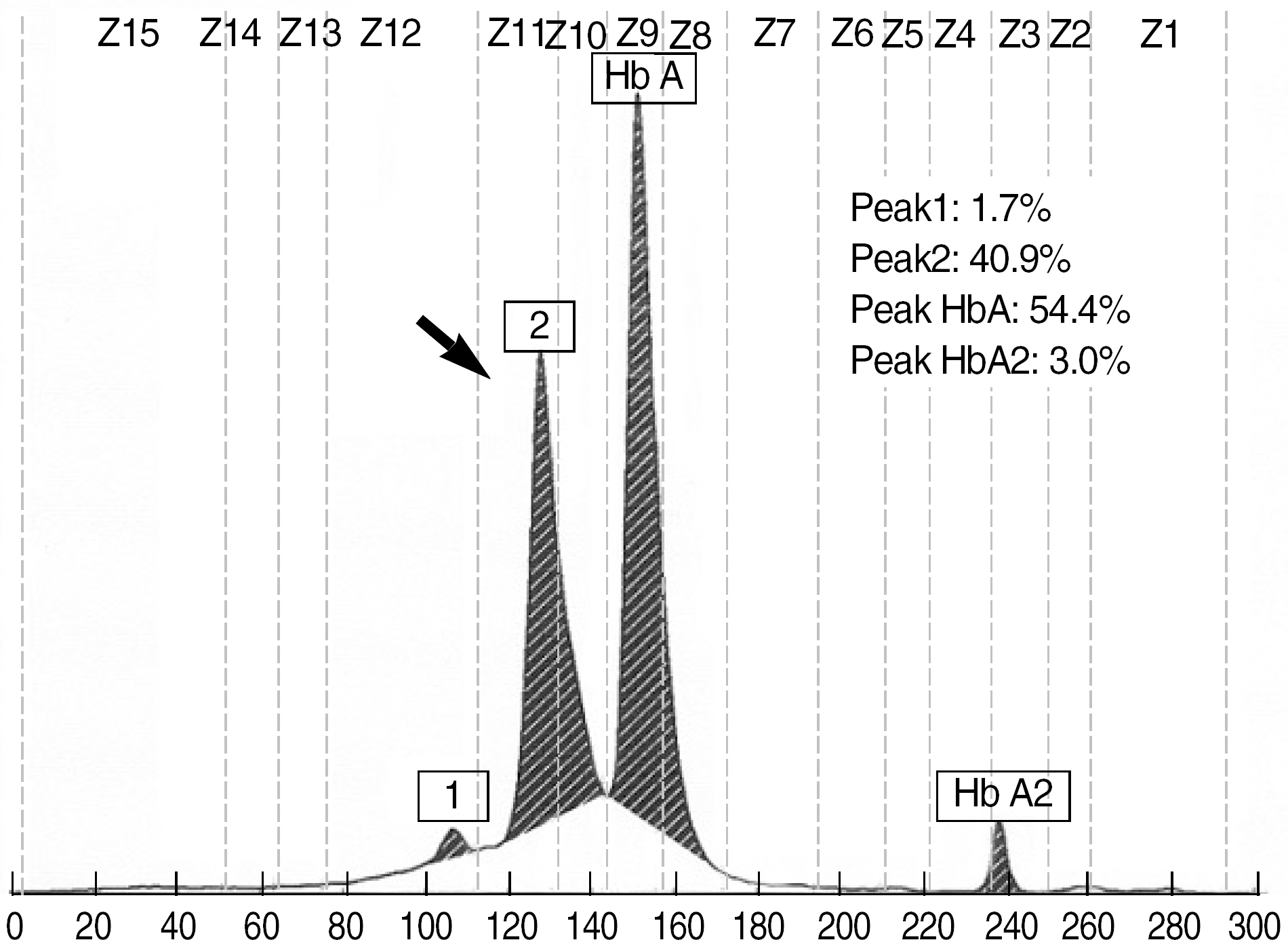Korean J Lab Med.
2009 Dec;29(6):536-540. 10.3343/kjlm.2009.29.6.536.
Hemoglobin Yamagata: Hemoglobin Variant Detected by HbA1c Test
- Affiliations
-
- 1Department of Laboratory Medicine, School of Medicine, Ewha Womans University, Seoul, Korea. kshong@ewha.ac.kr
- 2Department of Internal Medicine, School of Medicine, Ewha Womans University, Seoul, Korea.
- 3Department of Laboratory Medicine and Genetics, Samsung Medical Center, Sungkyunkwan University School of Medicine, Seoul, Korea.
- KMID: 1781607
- DOI: http://doi.org/10.3343/kjlm.2009.29.6.536
Abstract
- Hemoglobin (Hb) Yamagata is a rare Hb variant, which has been reported only twice-one case each in Japan and Korea. This variant arises from a Lys --> Asn substitution due to a mutation of AAA to AAC or AAT at codon 133 of the beta-globin gene. This study reports the third case of a patient detected with Hb Yamagata [HBB: c.399A>T; p.Lys133Asn] and discusses the effect of this variant on HbA1c measurement. This variant was detected in a 70-yr-old Korean man with diabetes mellitus during a routine follow-up. The HbA1c concentration determined using Variant ll Turbo (Bio-Rad, USA) was abnormally high at 47.9%. It was impossible to measure the HbA1c level accurately using Variant ll Thalassemia Mode (Bio-Rad, USA). However, the HbA1c levels analyzed by HLC-723 G7 (Tosoh, Japan), Cobas Integra (Roche, Switzerland) and NycoCard (Axis-Shield, Norway) were 5.0%, 8.0%, and 7.9%, respectively. This study shows that Hb Yamagata interferes with the accurate measurement of HbA1c levels in a diabetic patient. Taking these findings into consideration, we think that an immunoassay or affinity chromatography can be used as an alternate method for measuring the HbA1c level in a patient with this variant. In conclusion, a patient can be inferred to have an Hb variant if the HbA1c concentration is abnormally high or low or if there is a discrepancy between the results obtained using different methods, and if the clinical status of the patient suggests the presence of abnormal Hb. Subsequently, the HbA1c values can be determined by methods based on different principles.
Keyword
MeSH Terms
Figure
Cited by 1 articles
-
Diagnostic approaches for inherited hemolytic anemia in the genetic era
Yonggoo Kim, Joonhong Park, Myungshin Kim
Blood Res. 2017;52(2):84-94. doi: 10.5045/br.2017.52.2.84.
Reference
-
1.Bry L., Chen PC., Sacks DB. Effects of hemoglobin variants and chemically modified derivatives on assays for glycohemoglobin. Clin Chem. 2001. 47:153–63.
Article2.Shimizu A., Nakanishi T., Miyazaki A. Detection and characterization of variant and modified structures of proteins in blood and tissues by mass spectrometry. Mass Spectrom Rev. 2006. 25:686–712.
Article3.Harano T., Harano K., Ueda S., Imai K., Marubashi S. Hb Yamagata [beta 132 (H10)Lys——Asn]: a new abnormal hemoglobin in a Japanese family. Hemoglobin. 1990. 14:207–11.4.Han JY., Wee JH., Kim JM., Kim JY., Kim IH., Rodgers GP. A new observation of Hb Yamagata with a different nucleotide substitution: beta 132 AAA→ AAT. Hemoglobin. 1996. 20:165–8.5.Schnedl WJ., Lahousen T., Lang T., Lipp RW., Yonehara S., Fukunaga S, et al. Determination of glycated hemoglobin in clinically silent hemoglobin variants. Diabetes Metab Res Rev. 2004. 20:460–5.
Article6.Lee ST., Weykamp CW., Lee YW., Kim JW., Ki CS. Effects of 7 hemoglobin variants on the measurement of glycohemoglobin by 14 analytical methods. Clin Chem. 2007. 53:2202–5.
Article7.Lee ST., Kim MS., Choi DY., Kim SK., Ki CS. Incidence of variant hemoglobin (Hb) and increased fetal Hb concentrations and their effect on HbA1c measurement in a Korean population. Clin Chem. 2006. 52:1445–6.8.Nathan DM., Kuenen J., Borg R., Zheng H., Schoenfeld D., Heine RJ. A1c Derived Average Glucose Study Group. Translating the A1C assay into estimated average glucose values. Diabetes Care. 2008. 31:1473–8.9.Colah RB., Surve R., Sawant P., D'Souza E., Italia K., Phanasgaonkar S, et al. HPLC studies in hemoglobinopathies. Indian J Pediatr. 2007. 74:657–62.
Article10.Schnedl WJ., Liebminger A., Roller RE., Lipp RW., Krejs GJ. Hemoglobin variants and determination of glycated hemoglobin (HbA1c). Diabetes Metab Res Rev. 2001. 17:94–8.
Article11.Schnedl WJ., Krause R., Halwachs-Baumann G., Trinker M., Lipp RW., Krejs GJ. Evaluation of HbA1c determination methods in patients with hemoglobinopathies. Diabetes Care. 2000. 23:339–44.
Article
- Full Text Links
- Actions
-
Cited
- CITED
-
- Close
- Share
- Similar articles
-
- Evaluation of Dimension Hemoglobin A1c as an Emergency Outpatient Test
- Performance Evaluation of the DxC 700 AU Chemistry Analyzer in Hemoglobin A1c Measurement
- Evaluation of Analytical Performance of the D-100 Hemoglobin Testing System for Hemoglobin A1c Assay
- Comparing the Efficacy of Samsung LABGEO PT10 and Bio-Rad Variant II Turbo for HbA1c Measurement in Three Types of Blood Samples
- Effect of Iron Deficiency Anemia on Hemoglobin A1c Levels




